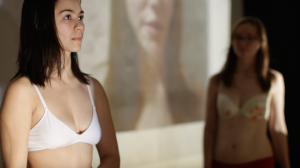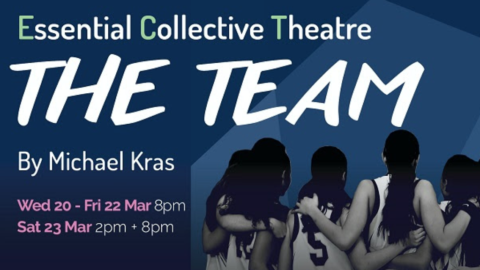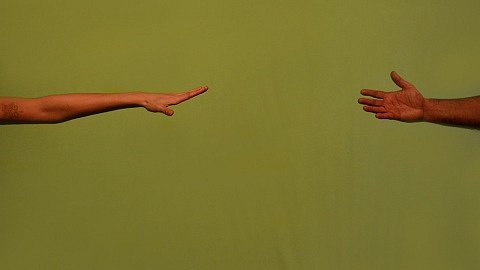This year, our student embedders become one of The Team, as they follow the creation process of Essential Theatre Collective‘s upcoming show. To start, they...
A Safe Space to Fail: A Look Inside The 38th Annual Rhubarb Festival
The 38th Rhubarb Festival at Buddies in Bad Times theatre is upon us! While our focus at DARTcritics is on theatre in the Niagara region, every once in a while we venture further afield —and the fact that this is billed as Canada’s longest-running new works festival and a “hotbed of creativity” certainly caught our eye!

Photo courtesy of Buddies in Bad Times.
So what’s Rhubarb? Staff writer Sarah Bradford spoke with curator Mel Hague about the history of the festival, and with performers/creators Claren Grosz and Keshia Palm whose performance of Shadow Girls is part of Rhubarb’s week two programming.
DARTcritics: Thank you for taking the time to speak with me; I know you must be busy with the festival! Could you tell me about the role you play in Rhubarb?
Hague: I’m a dramaturge and curator. I’ve been working at Buddies for three years now as the company dramaturge and Rhubarb Festival director. Most recently at Buddies I worked on Black Boys, directed by Jonathan Seinen.
DARTcritics: As someone who has never attended the festival, can you tell me more about it?
Hague: The Rhubarb Festival is an experimental theatre festival that’s been running since 1979. It is a festival for new experiments in theatre and new forms of theatre. All of the works come in at under 25 minutes—artists offer experimental performances that they’ve been working on or thinking about for some time. They aren’t necessarily full productions, but we give them full production value—they have our whole technical staff and our marketing team backing them up, and myself as an artistic associate.
When an audience member comes to the Rhubarb Festival they see multiple performances over the course of one evening, usually four or five shows in a row. We have two spaces where they can perform: the Chamber Space which is our black box theatre, and the Cabaret which doubles as a bar and club. Every half hour the audience member can choose which space to move into, so two audience members can come in the same night and see two completely different shows.
DARTcritics: And you provide the technical staff, facilities and equipment for each production?
Hague: Yes and we offer them an honorarium for their participation.
DARTcritics: What are you looking for, if anything, when you are programming for Rhubarb?
Hague: It’s completely open. From a curatorial standpoint I am looking for what is most necessary for each project to be put on in our facilities. As opposed to other festivals which produce new works like Summerworks, Fringe, and the Next Stage Festival, we showcase ideas that are not fully formed or ready to be put on at those festivals. In terms of theme, content, and form I’m not looking for anything specific; it varies widely. Its all about what Rhubarb can offer to a particular piece at a particular time.When I read the applications for these works in September and October, the distance between the application, what I read, and what’s going to go on stage can be quite far because they’ve been continuing to develop it in the four months leading up to Rhubarb.
DARTcritics: Do you only put on works of theatre and performance, or do you host art instillations or other forms?

Photo courtesy of Buddies in Bad Times.
Hague: In the past we’ve had small gallery exhibits—this year is more based on live performance and video. Sometimes we end up with dance projects or performance art.
This year we have the Rhubarb Haunted House where I’ve brought back eight pieces that have been in the festival over the last fifteen years. The audience will come into a gallery-like experience inspired by the haunted house aesthetic, meeting the ghosts of these shows. Its not restaging as much as reengaging with these pieces.
DARTcritics: How did the Rhubarb Festival come to fruition and how has it changed since its conception?
Hague: It was founded in 1979 by a group of Toronto artists who traveled to New York, saw what was going on in the way of performance art and the punk scene there, and decided to bring that ethos back with them. The first Rhubarb Festival took place in Queen West where punk in Toronto was flourishing. They really tapped into a queer, proto-alternative scene–alternative here meaning alternative to the work of places like Tarragon Theatre. It happened once a year and started out in basements and was heavily inspired by body performance art; it was highly political and very D.I.Y. It ran that way for about 10 or 15 years. Some of the founding people in that group went on to found some companies here in Toronto and four out of the five of them still exist: Necessary Angel, Nightwood Theatre, Buddies in Bad Times, and the Theatre Centre. Buddies took on the Rhubarb Festival out of the initial collective.
DARTcritics: What are your hopes for the future of Rhubarb; what do you hope to build upon in the next coming years?
Hague: I think that our generation of artists has a difficult time failing. The expectations are very high when it comes to public presentations of work, especially in Toronto.This affects the ethos of young artists, but that’s what being a young artist is about–risking, failure, and learning from failure. Rhubarb is a lot of things, but it is never boring. My hope is that we allow them the space to risk so far that they might fail, so when the successes happen they are glorious, and even the failures are blazing. Keeping Rhubarb going is crucial to this. We don’t allow reviews of the shows because, nowadays with access to social media, it takes focus away from the actual work of creating art that is new and engaging. My hope for the future is that young artists are given that space to fail. In theatre there is a such a tremendous amount of physical labour and time and that is what we really want to highlight.
DARTcritics: I’m really glad to hear you say that. Though our program at Brock University is highly involved in theory and there is a structured curriculum, something that many of our performance professors reiterate is not being afraid to fail, and fail gloriously because that is where the great work comes out of. Thank you so much for talking with me and I hope that the rest of Rhubarb runs well!
Now let’s hear from Claren Grosz and Keshia Palm, and what they had to say about their participation in the Rhubarb Festival from a performer’s perspective.

Keshia Palm (Left) and Claren Grosz (Right). Photo courtesy of Colin Murray.
DARTcritics: Thank you for taking the time to answer some questions! Could you tell me more about yourselves and about your performance piece at Rhubarb?
Grosz & Palm: We are both interdisciplinary artists who met while devising Persephone with Pencil Kit Productions [in the 2016 Toronto Fringe]. I [Claren] usually work as a director and a visual artist. We both are really interested in generating new work, especially in collective, devised settings. I [Keshia] am particularly interested in puppetry and mask and it was her interest in shadow puppetry that led to the development of our Rhubarb piece, Shadow Girls. We co-wrote it and perform in it together alongside a stellar all-lady tech team. Shadow Girls blends overhead projector art with performance to illuminate the struggle of two women navigating bisexual desire and identity.
DARTcritics: How did your piece come to be in Rhubarb? How did you hear about the Festival and what made you want to participate?
Grosz & Palm: We were early in our creation process and looking for safe, engaging, and exciting places to try out our ideas when the submissions for Rhubarb came up. It felt like the perfect fit for us. Rhubarb is all about pushing the boundaries of theatre, developing your craft and exploring the nuances of the queer experience. We were over the moon when we found out we’d be participating.
DARTcritics: In your piece, Shadow Girls, the two main characters are bisexual women who struggle with identity, sex, and shame—can you speak to the lack of bi-representation in mainstream media? What you are aiming to have your audiences walk away with after seeing your piece?
Grosz & Palm: Bisexuality really doesn’t come up much in the media. Certainly you rarely see it in fictional narratives, but even celebrities who openly identify as bisexual often face bi-erasure. As a young bi woman figuring out the nature of your sexuality it can be really difficult without seeing any representations of yourself to provide a kind of mirror.

Photo courtesy of Colin Murray.
One of the difficulties with bi representation and erasure is that your sexuality tends to be defined in the eyes of others by your current sexual partner. This was something we struggled with in our own piece, because we see our two characters engaging exclusively with each other. The story really is about their relationship to each other. Given that, how do we retain a sense of their sexual fluidity? As a collective we have a really clear understanding of where these women sit on that spectrum, and there are a lot of clues throughout the piece to let the audience in on this. Ultimately we hope people are able to absorb this snapshot of these womens’ lives and let go of gay/straight labels. These characters are both flawed and struggle with their sexuality in different ways. It’s important that we let them speak and listen without judgement.
DARTcritics: In an interview with Mel Hague, she stated that Rhubarb exists to give artists a safe space to fail and to build upon their work–hence not allowing for reviews of the performance. What are your thoughts about these policies?
Grosz & Palm: We’ve really let the nature of Rhubarb inform our creative process. We’ve had an extremely open, unorthodox approach to the development of the piece which was at times terrifying, but really illuminating.
For the first three weeks, we didn’t have a script; we were creating images and developing a visual vocabulary to build our piece on. We knew this was our opportunity to take risks and get things a little bit wrong before we committed to developing a full length production. We gave ourselves permission to really prioritize our visuals and the multitude of ways we could use overhead projectors in novel and exciting ways. Things might not be as clear as we would otherwise expect our work to be, but that’s okay if it allows us to dive deeper into our overhead projector art.
It’s comforting to know that you are a part of a larger event that is full of new, weird and wonderful work. There’s also a happy challenge to that, because we can’t be boring. We think we’ve done a good job at creating a really stunning visual whirlwind. The festival has also been so generous in providing things that wouldn’t be available to us otherwise—like a white dance floor!
DARTcritics: After Rhubarb do you plan to take this performance anywhere? What’s next for Shadow Girls?
Grosz & Palm: Absolutely. We don’t know where we will do it, but there is a full-length version of this play waiting to go. Our Rhubarb version just introduces the audience to these characters and their first moments of reconnection. There’s a whole relationship that develops from there. We’re not done with this team, these characters and this world yet.
For tickets to The Rhubarb Festival: http://buddiesinbadtimes.com/show/the-38th-rhubarb-festival/#weektwoprogram or 416-975-8555 (box office). Rhubarb runs until Sunday February 26th.
Related Posts
It’s been over a week since Essential Collective Theatre’s world premiere of Our Lady of Delicias opened at the FirstOntario Performing Arts Centre and...
Emma McCormick and Kristina Ojaperv write,
As our journey into the evolving form of embedded criticism begins, we feel the title of Jordi Mand’s new work...
It’s been over a week since Essential Collective Theatre’s world premiere of Our Lady of Delicias opened at the FirstOntario Performing Arts Centre and...
Emma McCormick and Kristina Ojaperv write, As our journey into the evolving form of embedded criticism begins, we feel the title of Jordi Mand’s new work...
Leave a Reply (Cancel Reply)
Twitter Feed
Blogroll
DARTcritics.com is partially funded by the Marilyn I. Walker School of Fine and Performing Arts, in support of student learning; experiential education; student professionalization; public engagement with the teaching, learning and production activities of the Department of Dramatic Arts; new ways of thinking; and the nurturing of links with our communities.





